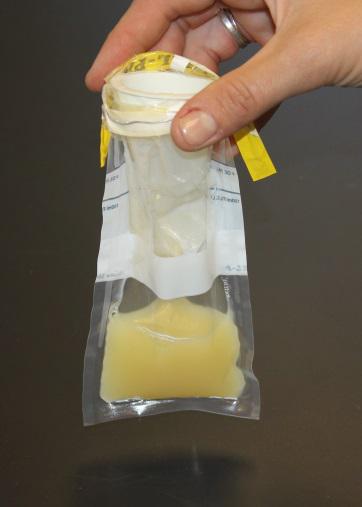Article
Urospermia or urine in the semen
By Dr. Patrick McCue
Diplomate American College of Theriogenologists
The semen collection was supposed to be traditional and uneventful. An 18 year old stallion was being collected as part of an every-other-day schedule during the breeding season. So far this year all of the collections had been routine and predictable. We would tease him briefly to the jump mare, wash off his penis and he would eagerly mount the phantom for collection and ejaculate normally.
However, when he dismounted today his semen was larger in volume than usual and yellow colored. The stallion had urinated during the collection procedure. The semen was examined and the progressive motility was only 30 %, instead of the usual 85 %. Measurement of semen pH and osmolality revealed values of 7.94 and 773 mOsm, respectively. The normal pH and osmolality for semen from this stallion were approximately 7.25 to 7.3 and 320 to 330, respectively. There was sufficient urine contamination in this collection to make the entire ejaculate unusable.
We decided to collect the stallion again. Unfortunately, he urinated in the next sample as well and this time all of the sperm were dead.

Causes of urospermia in stallions are not well defined. Neurologic abnormalities such as cauda equina neuritis, equine protozoal myeloencephalitis, equine herpesvirus 1 and sorghum toxicosis as well as medical conditions such as hyperkalemic periodic paralysis, cystitis and urolithiasis can all be associated with urospermia. In addition, some cases do not appear to be associated with a specific pathological or medical condition and may be behavioral in origin.
Semen contaminated with a small amount of urine may be usable if immediately diluted with a semen extender to decrease the adverse effects of pH and osmolality on sperm function. Another option could be centrifugation of the semen in an attempt to separate spermatozoa from urine crystals and solids.
A physical examination was performed on our stallion and no obvious musculoskeletal abnormalities were detected. Similarly, no abnormalities were noted on a neurologic evaluation. Blood samples were collected for a complete blood count and serum chemistry analysis and all parameters were within normal limits. No medical reasons for urospermia were detected.
Consequently, we formulated a plan to re-condition the stallion to ejaculate without urination. The affected stallion was placed into the stall of another stallion which still contained a fecal pile from that other stallion. Initially the affected stallion appeared to be very anxious to be in the stall of another stallion. However, after approximately 3 minutes the horse sniffed the fecal pile of the other stallion, postured over it and urinated on the fecal pile of the other stallion.
The stallion was then immediately brought into the breeding shed and semen was collected without urine contamination. The cycle of moving the stallion into another stall and allowing him to urinate was repeated three times on an every-other-day basis. Normal ejaculation in the absence of urine contamination occurred during each collection procedure and has been normal ever since.
Another management technique that may be employed to entice a stallion to urinate before semen collection is to remove the stallion from his normal stall, clean the stall and re-bed with fresh bedding and then return the horse to his stall. Most stallions will urinate within a few minutes to mark their territory.
In summary, urination during semen collection can be associated with decreased pregnancy rates due to the toxic effects of urine on sperm function. A physical examination should be performed to determine if there are any medical conditions that may have contributed to the urospermia. Urination in the ejaculate can become routine in some stallions. Reconditioning of the stallion and collection of a urine-free ejaculate can be accomplished by enticing the stallion to urinate before collection.
Animal Reproduction Systems
800-300-5143






